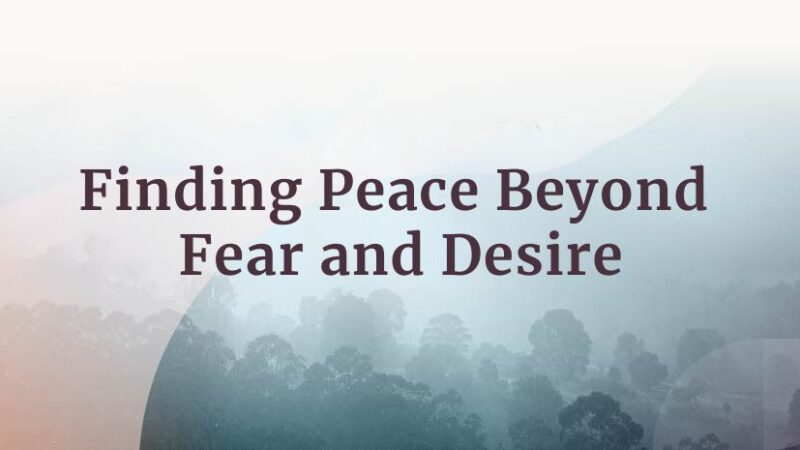-
E117: The Real Work: Letting Go from Within
Michael Singer — October 2, 2025
True spirituality isn’t about mystical experiences or lofty ideals—it’s about honestly facing...
-
Once More: Reflections on Reincarnation and the Gap Between Lives
Tami Simon — September 26, 2025
In this special reflection episode of Insights at the Edge host Tami Simon looks back on her...
-
Honey Tasting Meditation: Build Your Relationship with Sweetness
There is a saying that goes “hurt people hurt people.” I believe this to be true. We have been...
Written by:
Amy Burtaine, Michelle Cassandra Johnson
-
Many Voices, One Journey
The Sounds True Blog
Insights, reflections, and practices from Sounds True teachers, authors, staff, and more. Have a look—to find some inspiration and wisdom for uplifting your day.
Standing Together, and Stepping Up
Written By:
Tami Simon -
The Michael Singer Podcast
Your Highest Intention: Self-Realization
Michael Singer discusses intention—"perhaps the deepest thing we can talk about"—and the path to self-realization.
This Week:
E116: Doing the Best You Can: The Path to Liberation -
Many Voices, One Journey
The Sounds True Blog
Insights, reflections, and practices from Sounds True teachers, authors, staff, and more. Have a look—to find some inspiration and wisdom for uplifting your day.
Take Your Inner Child on Playdates
Written By:
Megan Sherer
600 Podcasts and Counting...
Subscribe to Insights at the Edge to hear all of Tami's interviews (transcripts available, too!), featuring Eckhart Tolle, Caroline Myss, Tara Brach, Jack Kornfield, Adyashanti, and many more.
Most Recent
Chianti Lomax: Evolving While Black: Happy, Authentic,...
How do Black women grow, transform, and make good use of the power they possess? In her new book, Evolving While Black, inspirational life coach and “Chief Happiness Curator” Chianti Lomax shares a guide to help Black women achieve authentic happiness and liberation on their own terms. This episode of Insights at the Edge brings you into her company with Sounds True founder Tami Simon as they discuss Chianti’s personal journey and the many practical approaches she teaches.
Give a listen to their conversation on: education, the golden key to improving your life; positive psychology; how exposure creates expansion; learning ways to flourish in the face of systemic racism and oppression; listening to hip-hop that empowers us; shifting from poverty to possibility; breaking free from the inherited belief systems that no longer serve you; mindfulness and emotions; what Chianti discovered while skydiving; the challenge of accurately assessing your own level of self-awareness; “polling your crew” to learn how you show up in life; the life satisfaction pie and how much of our happiness is ours to determine; journaling as a vehicle for rewriting your truth; taking your thoughts “to court”; optimism research and the A,B,C, D method; three dimensions of happiness: pleasure and gratification, strength and virtue, and meaning and purpose; self-acceptance and validation; setting healthy boundaries; and more.
Note: This episode originally aired on Sounds True One, where these special episodes of Insights at the Edge are available to watch live on video and with exclusive access to Q&As with our guests. Learn more at join.soundstrue.com.
E4: Finding Peace Beyond Fear and Desire
What creates the inner disturbances that cause us to struggle? At the root, teaches Michael Singer, lie the polarities of desire and fear: the psyche’s need to hold on to what it likes and push away what it doesn’t. In this episode, Michael reveals how inner freedom arises not from struggling with these forces but by allowing their natural flow of coming and going to pass right through us.
For more information, go to michaelsingerpodcast.com.
© Sounds True Inc. Episodes: © 2024 Michael A. Singer. All Rights Reserved.
E3: The Yoga of Letting Go – Staying True to You...
How do we free ourselves from the endless pull of external events and the turmoil of our thoughts and emotions—to return to the seat of the true self? Like a balloonist seeking to rise skyward, the key is to stop fighting the ropes that are holding us down, and to practice the moment-by-moment yoga of letting go. When we do, we cease to be an instrument of the personal self and start being a liberated expression of the divine will.
For more information, go to michaelsingerpodcast.com.
© Sounds True Inc. Episodes: © 2024 Michael A. Singer. All Rights Reserved.
Customer Favorites
Kristin Neff: The Yin and Yang of Self-Compassion
Kristin Neff is an associate professor at the University of Texas and the author of Self-Compassion: The Proven Power of Being Kind to Yourself. With Sounds True, she has recently published the audio program The Yin and Yang of Self-Compassion. In this episode of Insights at the Edge, Tami Simon speaks with Kristin about why it’s so difficult for so many people to treat themselves with actual compassion. Kristin explains that self-compassion is not some form of self-indulgence or excuse for bad behavior; indeed, there are actually various forms of self-compassion that arise in different situations. Tami and Kristin explore the roots of wrathful or angry self-compassion, including the mythological figures that embody this concept. Finally, they discuss the most common blocks to self-assertive compassion and the necessity of taking occasional “self-compassion breaks” to cultivate a better relationship within. (64 minutes)
Standing Together, and Stepping Up
Dear Sounds True friends and community,
While holding a mirror to our own organizational accountability, Sounds True unequivocally stands in solidarity with the Black community, the family of George Floyd, and the many others who have been victims of police brutality and ongoing racial injustice.
We stand with and for our Black employees, our Black authors and colleagues, our Black customers, and all of the protestors and social change activists—past, present, and future— who are working to put an end to racism in every corner of our society.
And we are committed to not just stand in solidarity but to step up.
Since George Floyd’s murder, we have been having many in-depth discussions among the 125-person staff at Sounds True about the most meaningful actions we can take as a transformational learning company to help educate ourselves and our community and contribute to the dismantling of racism.
We have been asking ourselves questions such as:
- How can we best use our platform to better amplify the voices of wisdom teachers who are Black, Indigenous, and People of Color (BIPOC)?
- What’s in our Shadow, as individuals and as an organization? What unconscious areas must now be brought into awareness?
- And how do we actively address these areas so that we can evolve as an organization and be a force of genuine service in the world?
The answers to these questions are not simple, quick, or easy. It has taken me a while to write this email to you, our beloved customers and Sounds True community, because we have felt as a team the need to listen carefully and look deeply within in order to lay out an action plan moving forward that will contribute to meaningful and substantive change.
Anything less falls short of what I believe this moment is asking of us.
We also want to learn and evolve in partnership with you. We are learning and growing together as a community, and it has been important for us to create a moving-forward action plan that invites engagement from our entire audience.
With arms wide open, I invite you to witness, support, and step up with us in the following ways:
- Over the next two years, Sounds True will be undergoing an in-depth Diversity, Equity, and Inclusion Training in the workplace. This training initiative has been in development for over a year, and will be provided by TMI Consulting, led by Dr. Tiffany Jana. Dr. Jana is coauthor of the books Overcoming Bias, Erasing Institutional Bias, and Subtle Acts of Exclusion. As part of the training, we will be uncovering how unconscious bias, microaggressions, and micro-acts of exclusion show up in the workplace, in our personal lives, and even in our products. The training also includes a thorough audit of Sounds True’s hiring practices, HR policies, marketing materials, and more.
- Sounds True also wants to include our customers, authors, and partner businesses in the introductory phase of this training process that we will be embarking upon. With that in mind, we are hosting a three-part webinar series on “Healing Racism” with Dr. Jana, beginning on Wednesday, June 24, at 8:00 pm ET | 5:00 pm PT. The series is free, and we are inviting our customers, authors, and business associates to join the Sounds True staff for this online training and to walk this part of our journey together. As someone on our email list, you will be receiving all of the details in future emails.
- It is clear to us at Sounds True that we need to publish and otherwise amplify the voices of more authors and presenters who are Black, Indigenous, and People of Color. If you have ideas about new BIPOC authors you would like to see published at Sounds True or included in our summits and online offerings, please write to us at acquisitions@soundstrue.com.
- The Sounds True Foundation, formed in 2018, is increasing its efforts to raise scholarship funds for BIPOC students to attend our Mindfulness Meditation Teacher Certification Program and become trained as mindfulness teachers who will bring this practice to diverse communities all over the world. We will be hosting a virtual fundraiser on June 30 for this initiative and will be emailing you with more details.
As I mentioned, working to dismantle and heal racism—in ourselves, in our organization, and in our world—is not a flash-in-the-pan effort at Sounds True. This is a long-haul commitment to the creation of a different world that is just, kind, and equitable. And we have a heckuva road to travel with you to get there.
And we are committed. We don’t want to simply talk about spiritual awakening. We want to embody it … as individuals, as a company, and as a force in the world. Humbly and boldly, we are going to give everything we have and invite you to do the same. This is the time for us to step up, together.
With love on the journey,

Tami Simon
Founder and Publisher, Sounds True
P.S. You can learn more about our commitment to creating a more compassionate world here.
Brené Brown: The Courage to be Vulnerable
Tami Simon speaks with Dr. Brené Brown, a research professor at the University of Houston’s graduate college of social work who has spent the past decade studying vulnerability, courage, authenticity, and shame. Brené is the author of the #1 New York Times bestseller Daring Greatly, and with Sounds True she has created the audio learning course The Power of Vulnerability: Teachings on Authenticity, Courage, and Connection. In this episode, Tami speaks with Brené about the cultural myth that equates vulnerability as weakness instead of recognizing it as the greatest measure of our courage. They also examine Brené’s research about the qualities that allow someone to live in a wholehearted way. (66 minutes)





